Food Security in India: Climate Resilience and Policy Analysis
VerifiedAdded on 2022/10/01
|13
|3938
|299
Report
AI Summary
This report provides a comprehensive analysis of food security in India, examining the country's food system, challenges, and implications. It highlights the importance of achieving food security, defined as access to sufficient, safe, and healthy food. The paper discusses India's economic growth and its self-sufficiency in staple foods like rice and wheat. However, it also addresses the challenges of undernutrition, micronutrient deficiencies, and the impact of climate change on food production. The report analyzes the food system, including the prevalence of cereal-based diets, water and sanitation issues, and gender inequalities. It explores risks such as climate change, population growth, and the vulnerability of agriculture to monsoon variability. The report also discusses government policies, food reserves, and the role of organizations like the Food and Agriculture Organization (FAO) in promoting agricultural productivity. Finally, it emphasizes the need for actions to improve resilience, particularly in the face of climate change and its impact on food security in India.
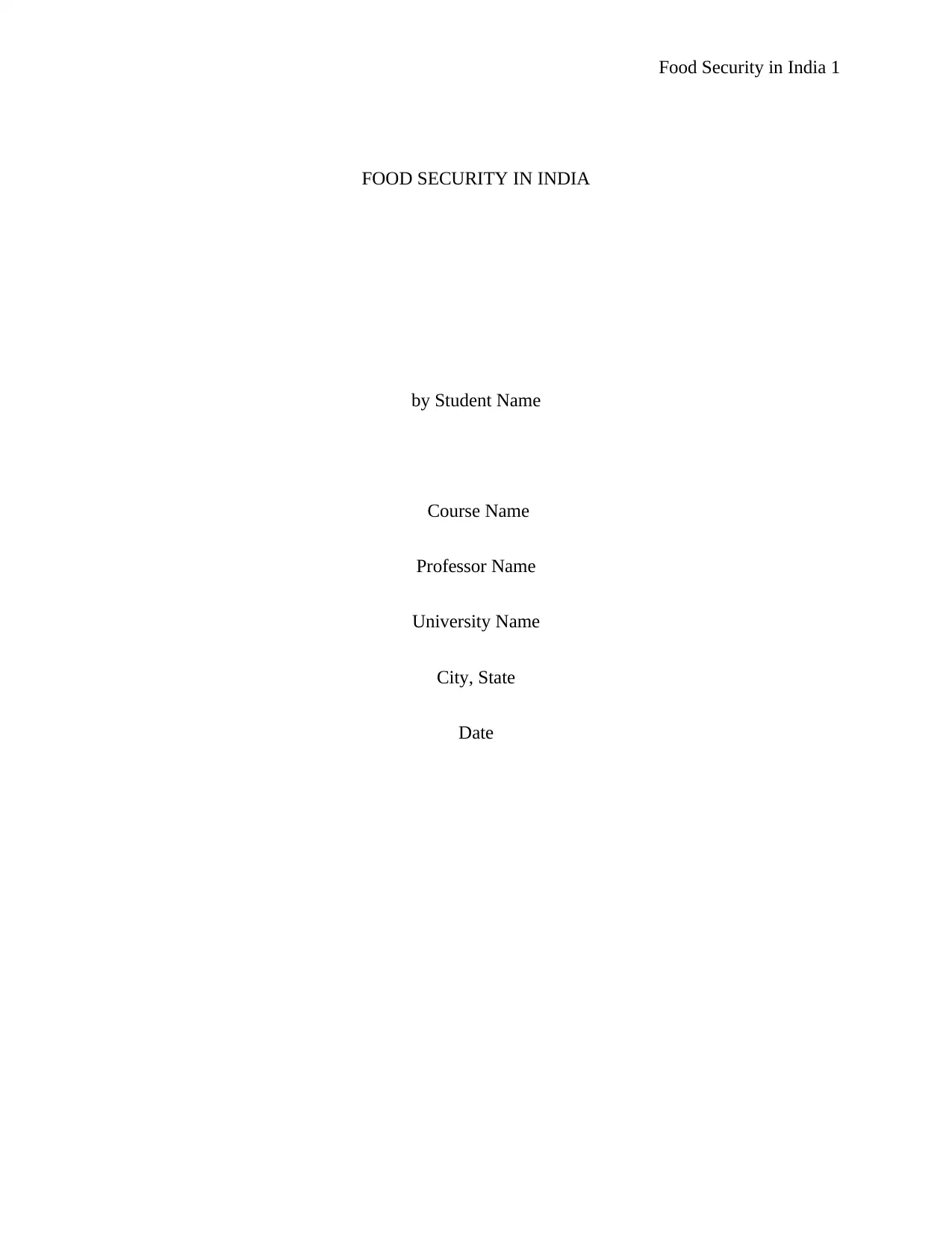
Food Security in India 1
FOOD SECURITY IN INDIA
by Student Name
Course Name
Professor Name
University Name
City, State
Date
FOOD SECURITY IN INDIA
by Student Name
Course Name
Professor Name
University Name
City, State
Date
Paraphrase This Document
Need a fresh take? Get an instant paraphrase of this document with our AI Paraphraser
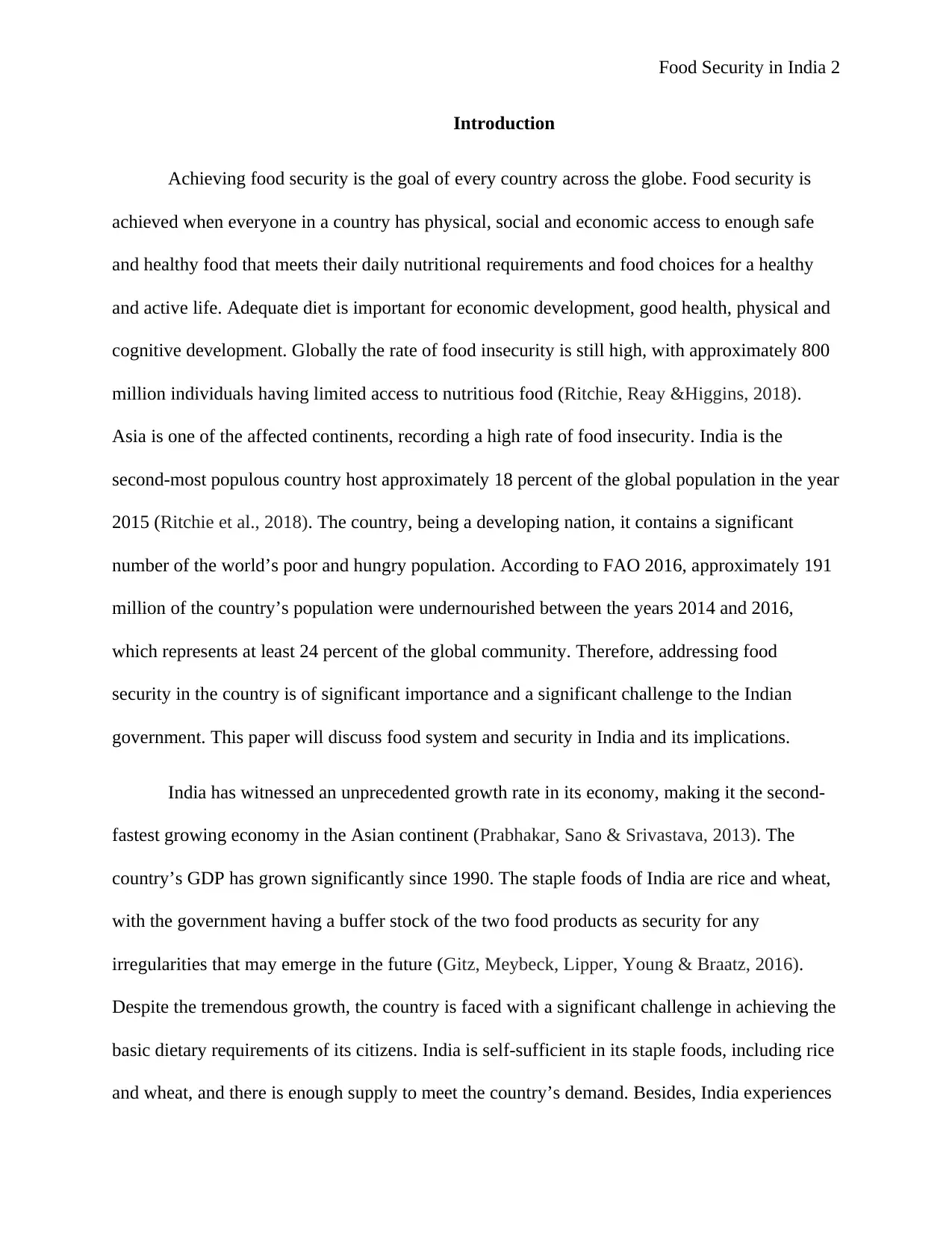
Food Security in India 2
Introduction
Achieving food security is the goal of every country across the globe. Food security is
achieved when everyone in a country has physical, social and economic access to enough safe
and healthy food that meets their daily nutritional requirements and food choices for a healthy
and active life. Adequate diet is important for economic development, good health, physical and
cognitive development. Globally the rate of food insecurity is still high, with approximately 800
million individuals having limited access to nutritious food (Ritchie, Reay &Higgins, 2018).
Asia is one of the affected continents, recording a high rate of food insecurity. India is the
second-most populous country host approximately 18 percent of the global population in the year
2015 (Ritchie et al., 2018). The country, being a developing nation, it contains a significant
number of the world’s poor and hungry population. According to FAO 2016, approximately 191
million of the country’s population were undernourished between the years 2014 and 2016,
which represents at least 24 percent of the global community. Therefore, addressing food
security in the country is of significant importance and a significant challenge to the Indian
government. This paper will discuss food system and security in India and its implications.
India has witnessed an unprecedented growth rate in its economy, making it the second-
fastest growing economy in the Asian continent (Prabhakar, Sano & Srivastava, 2013). The
country’s GDP has grown significantly since 1990. The staple foods of India are rice and wheat,
with the government having a buffer stock of the two food products as security for any
irregularities that may emerge in the future (Gitz, Meybeck, Lipper, Young & Braatz, 2016).
Despite the tremendous growth, the country is faced with a significant challenge in achieving the
basic dietary requirements of its citizens. India is self-sufficient in its staple foods, including rice
and wheat, and there is enough supply to meet the country’s demand. Besides, India experiences
Introduction
Achieving food security is the goal of every country across the globe. Food security is
achieved when everyone in a country has physical, social and economic access to enough safe
and healthy food that meets their daily nutritional requirements and food choices for a healthy
and active life. Adequate diet is important for economic development, good health, physical and
cognitive development. Globally the rate of food insecurity is still high, with approximately 800
million individuals having limited access to nutritious food (Ritchie, Reay &Higgins, 2018).
Asia is one of the affected continents, recording a high rate of food insecurity. India is the
second-most populous country host approximately 18 percent of the global population in the year
2015 (Ritchie et al., 2018). The country, being a developing nation, it contains a significant
number of the world’s poor and hungry population. According to FAO 2016, approximately 191
million of the country’s population were undernourished between the years 2014 and 2016,
which represents at least 24 percent of the global community. Therefore, addressing food
security in the country is of significant importance and a significant challenge to the Indian
government. This paper will discuss food system and security in India and its implications.
India has witnessed an unprecedented growth rate in its economy, making it the second-
fastest growing economy in the Asian continent (Prabhakar, Sano & Srivastava, 2013). The
country’s GDP has grown significantly since 1990. The staple foods of India are rice and wheat,
with the government having a buffer stock of the two food products as security for any
irregularities that may emerge in the future (Gitz, Meybeck, Lipper, Young & Braatz, 2016).
Despite the tremendous growth, the country is faced with a significant challenge in achieving the
basic dietary requirements of its citizens. India is self-sufficient in its staple foods, including rice
and wheat, and there is enough supply to meet the country’s demand. Besides, India experiences

Food Security in India 3
numerous population growth as well as environmental and dietary pressures. Therefore, the
country is faced with insufficient calorie intake and undernutrition among a significant
proportion of its citizens. Despite being self-sufficient, the country has a substantial number of
its citizens who exhibit poor nutritional health (Kwasek, 2012). The country has successfully
integrated the program to promote access to food for its growing population. India is, however,
limited in ensuring that it includes the required diversity in the types of foods available. The
country’s population experiences micronutrient deficiencies, mainly attributed to the focus on the
availability of calories rather than dietary diversity (Kwasek, 2012). The country has poor water
management and subsidies that lead to wasteful agricultural practices that serve as a significant
risk to the country’s food security.
Analysis of the Food System
Most of the foods consumed in India are cereal-based foods, including wheat, rice, and
millet. Rice and wheat are the main food crops to the Indian population. Maize in India is also a
common food; however, it is grown for both human and animal consumption. Other crops grown
in the country include millet, pulses, and sugarcane (Prabhakar et al., 2013). The variety of food
crops grown in the country is highly dependent on the variation in soils, climate, and cultivation
practices.
In India, there is a high prevalence of minor illnesses, for instance, fever, cough, and
diarrhea. The prevalence of the conditions varies with the socioeconomic conditions of the
country’s population. The conditions are highly prevalent among poor and uneducated
individuals (Brahmanand et al., 2013). Recently there have been improvements one the
prevalence of the diseases due to the improvement of the living conditions. At least 163 million
of the country’s citizen do not have access to clean water ( Aper, 2013). Also, due to climate
numerous population growth as well as environmental and dietary pressures. Therefore, the
country is faced with insufficient calorie intake and undernutrition among a significant
proportion of its citizens. Despite being self-sufficient, the country has a substantial number of
its citizens who exhibit poor nutritional health (Kwasek, 2012). The country has successfully
integrated the program to promote access to food for its growing population. India is, however,
limited in ensuring that it includes the required diversity in the types of foods available. The
country’s population experiences micronutrient deficiencies, mainly attributed to the focus on the
availability of calories rather than dietary diversity (Kwasek, 2012). The country has poor water
management and subsidies that lead to wasteful agricultural practices that serve as a significant
risk to the country’s food security.
Analysis of the Food System
Most of the foods consumed in India are cereal-based foods, including wheat, rice, and
millet. Rice and wheat are the main food crops to the Indian population. Maize in India is also a
common food; however, it is grown for both human and animal consumption. Other crops grown
in the country include millet, pulses, and sugarcane (Prabhakar et al., 2013). The variety of food
crops grown in the country is highly dependent on the variation in soils, climate, and cultivation
practices.
In India, there is a high prevalence of minor illnesses, for instance, fever, cough, and
diarrhea. The prevalence of the conditions varies with the socioeconomic conditions of the
country’s population. The conditions are highly prevalent among poor and uneducated
individuals (Brahmanand et al., 2013). Recently there have been improvements one the
prevalence of the diseases due to the improvement of the living conditions. At least 163 million
of the country’s citizen do not have access to clean water ( Aper, 2013). Also, due to climate
⊘ This is a preview!⊘
Do you want full access?
Subscribe today to unlock all pages.

Trusted by 1+ million students worldwide
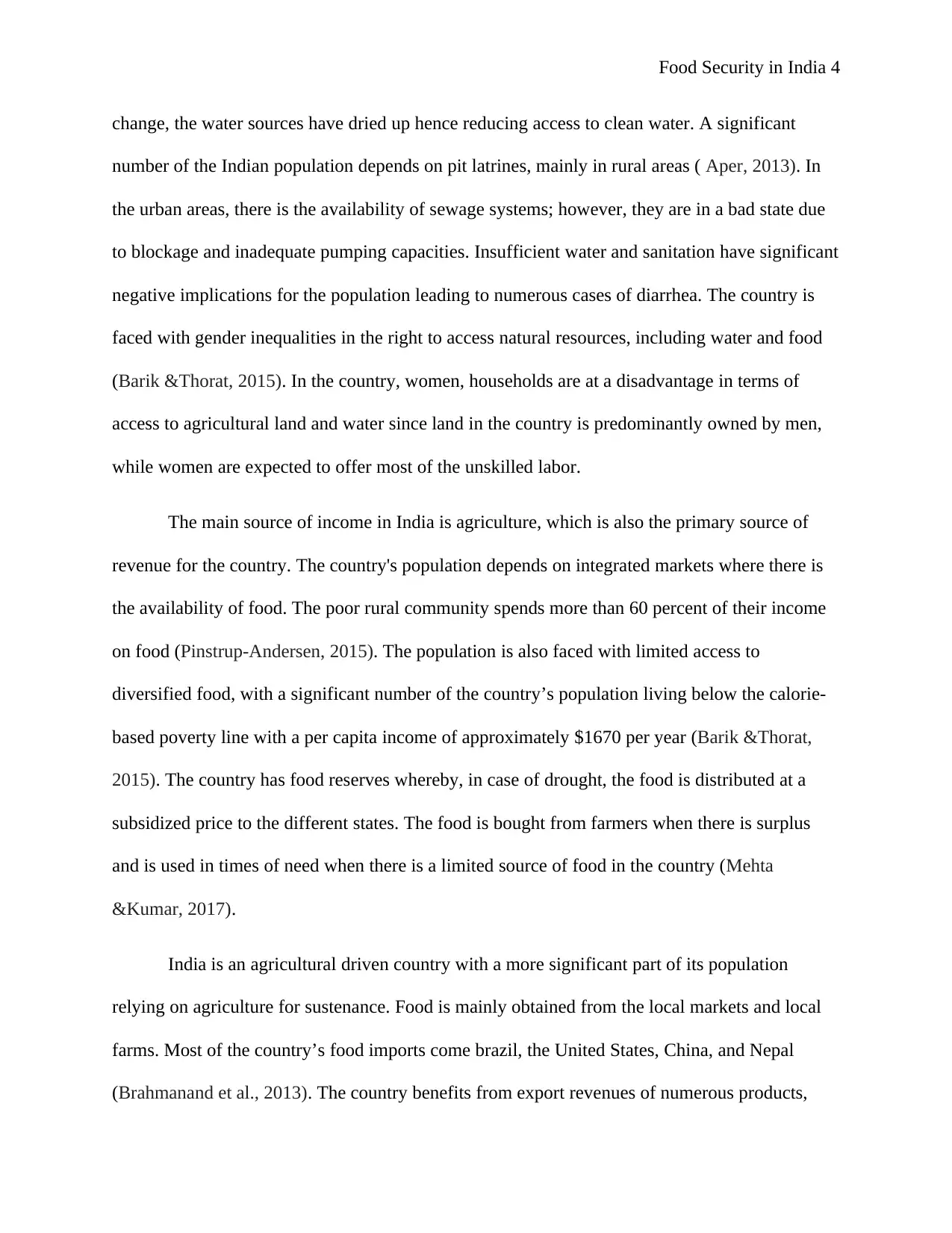
Food Security in India 4
change, the water sources have dried up hence reducing access to clean water. A significant
number of the Indian population depends on pit latrines, mainly in rural areas ( Aper, 2013). In
the urban areas, there is the availability of sewage systems; however, they are in a bad state due
to blockage and inadequate pumping capacities. Insufficient water and sanitation have significant
negative implications for the population leading to numerous cases of diarrhea. The country is
faced with gender inequalities in the right to access natural resources, including water and food
(Barik &Thorat, 2015). In the country, women, households are at a disadvantage in terms of
access to agricultural land and water since land in the country is predominantly owned by men,
while women are expected to offer most of the unskilled labor.
The main source of income in India is agriculture, which is also the primary source of
revenue for the country. The country's population depends on integrated markets where there is
the availability of food. The poor rural community spends more than 60 percent of their income
on food (Pinstrup-Andersen, 2015). The population is also faced with limited access to
diversified food, with a significant number of the country’s population living below the calorie-
based poverty line with a per capita income of approximately $1670 per year (Barik &Thorat,
2015). The country has food reserves whereby, in case of drought, the food is distributed at a
subsidized price to the different states. The food is bought from farmers when there is surplus
and is used in times of need when there is a limited source of food in the country (Mehta
&Kumar, 2017).
India is an agricultural driven country with a more significant part of its population
relying on agriculture for sustenance. Food is mainly obtained from the local markets and local
farms. Most of the country’s food imports come brazil, the United States, China, and Nepal
(Brahmanand et al., 2013). The country benefits from export revenues of numerous products,
change, the water sources have dried up hence reducing access to clean water. A significant
number of the Indian population depends on pit latrines, mainly in rural areas ( Aper, 2013). In
the urban areas, there is the availability of sewage systems; however, they are in a bad state due
to blockage and inadequate pumping capacities. Insufficient water and sanitation have significant
negative implications for the population leading to numerous cases of diarrhea. The country is
faced with gender inequalities in the right to access natural resources, including water and food
(Barik &Thorat, 2015). In the country, women, households are at a disadvantage in terms of
access to agricultural land and water since land in the country is predominantly owned by men,
while women are expected to offer most of the unskilled labor.
The main source of income in India is agriculture, which is also the primary source of
revenue for the country. The country's population depends on integrated markets where there is
the availability of food. The poor rural community spends more than 60 percent of their income
on food (Pinstrup-Andersen, 2015). The population is also faced with limited access to
diversified food, with a significant number of the country’s population living below the calorie-
based poverty line with a per capita income of approximately $1670 per year (Barik &Thorat,
2015). The country has food reserves whereby, in case of drought, the food is distributed at a
subsidized price to the different states. The food is bought from farmers when there is surplus
and is used in times of need when there is a limited source of food in the country (Mehta
&Kumar, 2017).
India is an agricultural driven country with a more significant part of its population
relying on agriculture for sustenance. Food is mainly obtained from the local markets and local
farms. Most of the country’s food imports come brazil, the United States, China, and Nepal
(Brahmanand et al., 2013). The country benefits from export revenues of numerous products,
Paraphrase This Document
Need a fresh take? Get an instant paraphrase of this document with our AI Paraphraser
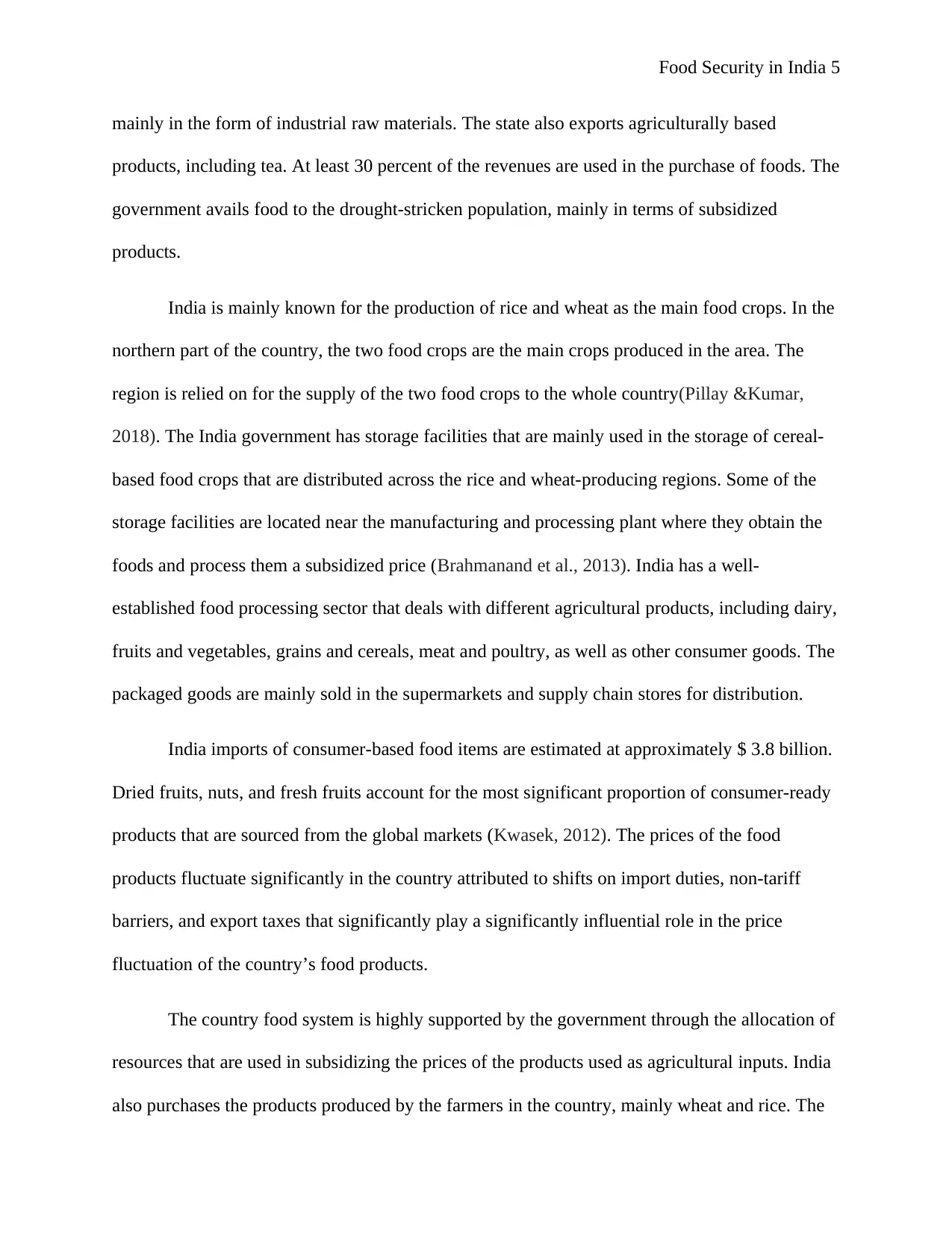
Food Security in India 5
mainly in the form of industrial raw materials. The state also exports agriculturally based
products, including tea. At least 30 percent of the revenues are used in the purchase of foods. The
government avails food to the drought-stricken population, mainly in terms of subsidized
products.
India is mainly known for the production of rice and wheat as the main food crops. In the
northern part of the country, the two food crops are the main crops produced in the area. The
region is relied on for the supply of the two food crops to the whole country(Pillay &Kumar,
2018). The India government has storage facilities that are mainly used in the storage of cereal-
based food crops that are distributed across the rice and wheat-producing regions. Some of the
storage facilities are located near the manufacturing and processing plant where they obtain the
foods and process them a subsidized price (Brahmanand et al., 2013). India has a well-
established food processing sector that deals with different agricultural products, including dairy,
fruits and vegetables, grains and cereals, meat and poultry, as well as other consumer goods. The
packaged goods are mainly sold in the supermarkets and supply chain stores for distribution.
India imports of consumer-based food items are estimated at approximately $ 3.8 billion.
Dried fruits, nuts, and fresh fruits account for the most significant proportion of consumer-ready
products that are sourced from the global markets (Kwasek, 2012). The prices of the food
products fluctuate significantly in the country attributed to shifts on import duties, non-tariff
barriers, and export taxes that significantly play a significantly influential role in the price
fluctuation of the country’s food products.
The country food system is highly supported by the government through the allocation of
resources that are used in subsidizing the prices of the products used as agricultural inputs. India
also purchases the products produced by the farmers in the country, mainly wheat and rice. The
mainly in the form of industrial raw materials. The state also exports agriculturally based
products, including tea. At least 30 percent of the revenues are used in the purchase of foods. The
government avails food to the drought-stricken population, mainly in terms of subsidized
products.
India is mainly known for the production of rice and wheat as the main food crops. In the
northern part of the country, the two food crops are the main crops produced in the area. The
region is relied on for the supply of the two food crops to the whole country(Pillay &Kumar,
2018). The India government has storage facilities that are mainly used in the storage of cereal-
based food crops that are distributed across the rice and wheat-producing regions. Some of the
storage facilities are located near the manufacturing and processing plant where they obtain the
foods and process them a subsidized price (Brahmanand et al., 2013). India has a well-
established food processing sector that deals with different agricultural products, including dairy,
fruits and vegetables, grains and cereals, meat and poultry, as well as other consumer goods. The
packaged goods are mainly sold in the supermarkets and supply chain stores for distribution.
India imports of consumer-based food items are estimated at approximately $ 3.8 billion.
Dried fruits, nuts, and fresh fruits account for the most significant proportion of consumer-ready
products that are sourced from the global markets (Kwasek, 2012). The prices of the food
products fluctuate significantly in the country attributed to shifts on import duties, non-tariff
barriers, and export taxes that significantly play a significantly influential role in the price
fluctuation of the country’s food products.
The country food system is highly supported by the government through the allocation of
resources that are used in subsidizing the prices of the products used as agricultural inputs. India
also purchases the products produced by the farmers in the country, mainly wheat and rice. The
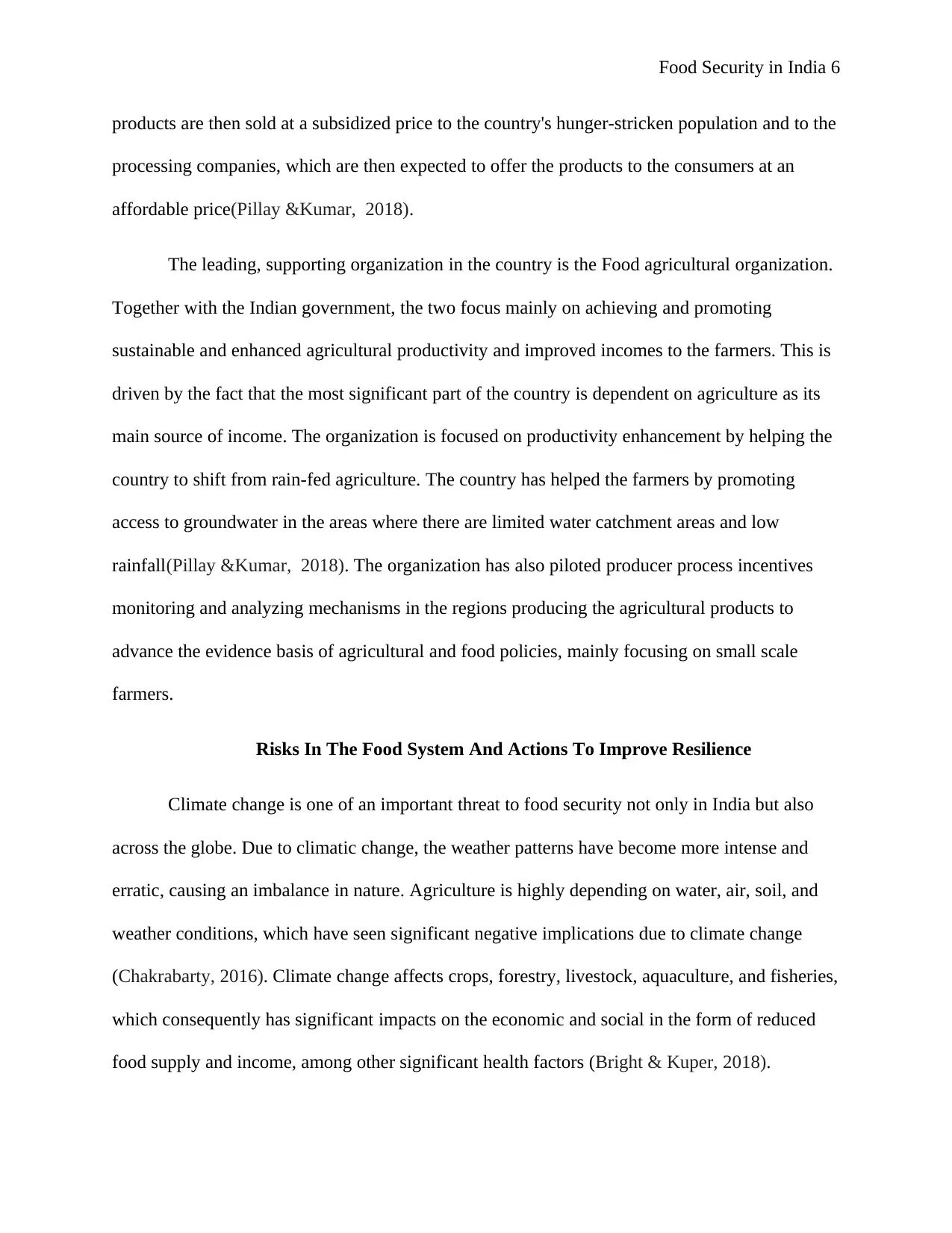
Food Security in India 6
products are then sold at a subsidized price to the country's hunger-stricken population and to the
processing companies, which are then expected to offer the products to the consumers at an
affordable price(Pillay &Kumar, 2018).
The leading, supporting organization in the country is the Food agricultural organization.
Together with the Indian government, the two focus mainly on achieving and promoting
sustainable and enhanced agricultural productivity and improved incomes to the farmers. This is
driven by the fact that the most significant part of the country is dependent on agriculture as its
main source of income. The organization is focused on productivity enhancement by helping the
country to shift from rain-fed agriculture. The country has helped the farmers by promoting
access to groundwater in the areas where there are limited water catchment areas and low
rainfall(Pillay &Kumar, 2018). The organization has also piloted producer process incentives
monitoring and analyzing mechanisms in the regions producing the agricultural products to
advance the evidence basis of agricultural and food policies, mainly focusing on small scale
farmers.
Risks In The Food System And Actions To Improve Resilience
Climate change is one of an important threat to food security not only in India but also
across the globe. Due to climatic change, the weather patterns have become more intense and
erratic, causing an imbalance in nature. Agriculture is highly depending on water, air, soil, and
weather conditions, which have seen significant negative implications due to climate change
(Chakrabarty, 2016). Climate change affects crops, forestry, livestock, aquaculture, and fisheries,
which consequently has significant impacts on the economic and social in the form of reduced
food supply and income, among other significant health factors (Bright & Kuper, 2018).
products are then sold at a subsidized price to the country's hunger-stricken population and to the
processing companies, which are then expected to offer the products to the consumers at an
affordable price(Pillay &Kumar, 2018).
The leading, supporting organization in the country is the Food agricultural organization.
Together with the Indian government, the two focus mainly on achieving and promoting
sustainable and enhanced agricultural productivity and improved incomes to the farmers. This is
driven by the fact that the most significant part of the country is dependent on agriculture as its
main source of income. The organization is focused on productivity enhancement by helping the
country to shift from rain-fed agriculture. The country has helped the farmers by promoting
access to groundwater in the areas where there are limited water catchment areas and low
rainfall(Pillay &Kumar, 2018). The organization has also piloted producer process incentives
monitoring and analyzing mechanisms in the regions producing the agricultural products to
advance the evidence basis of agricultural and food policies, mainly focusing on small scale
farmers.
Risks In The Food System And Actions To Improve Resilience
Climate change is one of an important threat to food security not only in India but also
across the globe. Due to climatic change, the weather patterns have become more intense and
erratic, causing an imbalance in nature. Agriculture is highly depending on water, air, soil, and
weather conditions, which have seen significant negative implications due to climate change
(Chakrabarty, 2016). Climate change affects crops, forestry, livestock, aquaculture, and fisheries,
which consequently has significant impacts on the economic and social in the form of reduced
food supply and income, among other significant health factors (Bright & Kuper, 2018).
⊘ This is a preview!⊘
Do you want full access?
Subscribe today to unlock all pages.

Trusted by 1+ million students worldwide
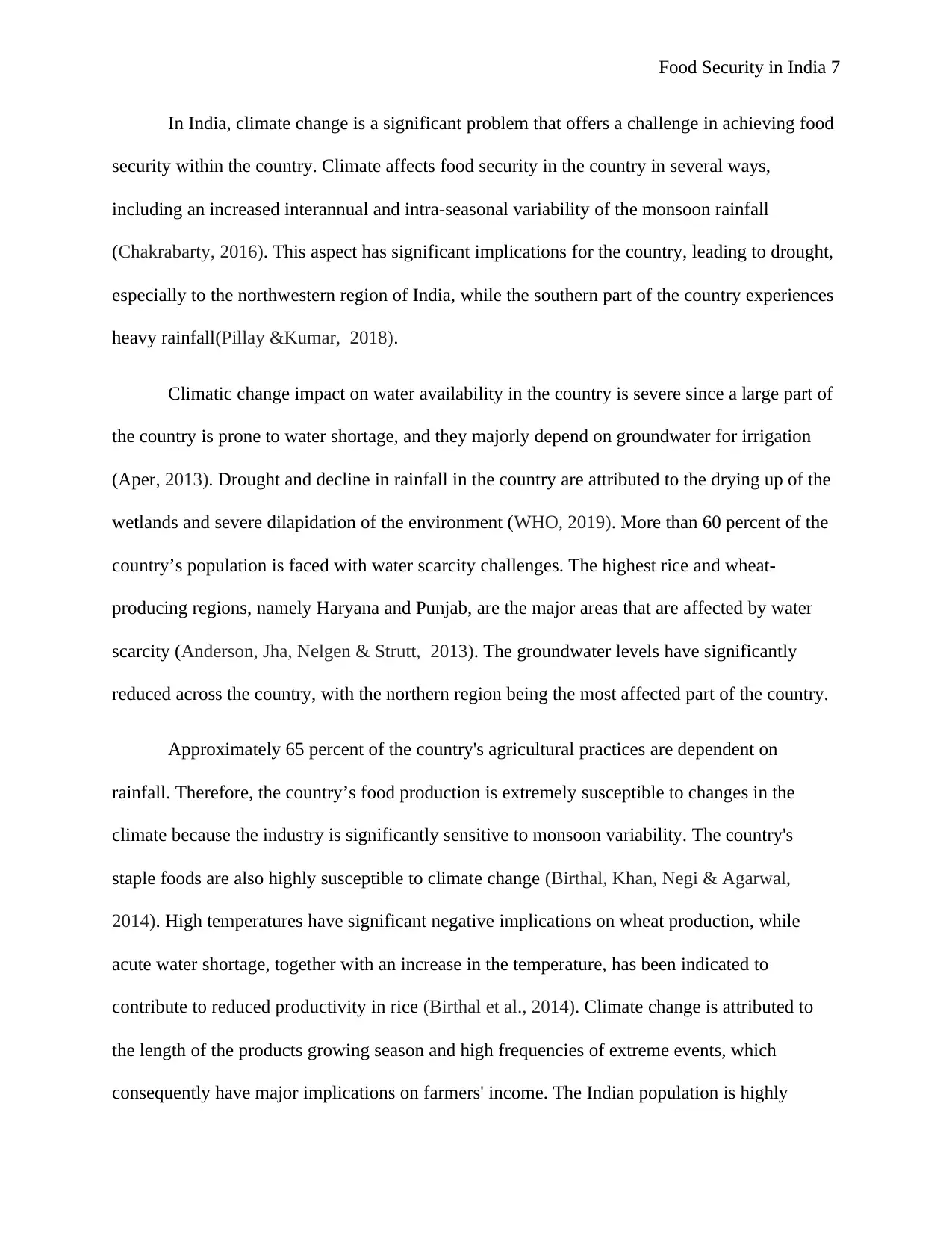
Food Security in India 7
In India, climate change is a significant problem that offers a challenge in achieving food
security within the country. Climate affects food security in the country in several ways,
including an increased interannual and intra-seasonal variability of the monsoon rainfall
(Chakrabarty, 2016). This aspect has significant implications for the country, leading to drought,
especially to the northwestern region of India, while the southern part of the country experiences
heavy rainfall(Pillay &Kumar, 2018).
Climatic change impact on water availability in the country is severe since a large part of
the country is prone to water shortage, and they majorly depend on groundwater for irrigation
(Aper, 2013). Drought and decline in rainfall in the country are attributed to the drying up of the
wetlands and severe dilapidation of the environment (WHO, 2019). More than 60 percent of the
country’s population is faced with water scarcity challenges. The highest rice and wheat-
producing regions, namely Haryana and Punjab, are the major areas that are affected by water
scarcity (Anderson, Jha, Nelgen & Strutt, 2013). The groundwater levels have significantly
reduced across the country, with the northern region being the most affected part of the country.
Approximately 65 percent of the country's agricultural practices are dependent on
rainfall. Therefore, the country’s food production is extremely susceptible to changes in the
climate because the industry is significantly sensitive to monsoon variability. The country's
staple foods are also highly susceptible to climate change (Birthal, Khan, Negi & Agarwal,
2014). High temperatures have significant negative implications on wheat production, while
acute water shortage, together with an increase in the temperature, has been indicated to
contribute to reduced productivity in rice (Birthal et al., 2014). Climate change is attributed to
the length of the products growing season and high frequencies of extreme events, which
consequently have major implications on farmers' income. The Indian population is highly
In India, climate change is a significant problem that offers a challenge in achieving food
security within the country. Climate affects food security in the country in several ways,
including an increased interannual and intra-seasonal variability of the monsoon rainfall
(Chakrabarty, 2016). This aspect has significant implications for the country, leading to drought,
especially to the northwestern region of India, while the southern part of the country experiences
heavy rainfall(Pillay &Kumar, 2018).
Climatic change impact on water availability in the country is severe since a large part of
the country is prone to water shortage, and they majorly depend on groundwater for irrigation
(Aper, 2013). Drought and decline in rainfall in the country are attributed to the drying up of the
wetlands and severe dilapidation of the environment (WHO, 2019). More than 60 percent of the
country’s population is faced with water scarcity challenges. The highest rice and wheat-
producing regions, namely Haryana and Punjab, are the major areas that are affected by water
scarcity (Anderson, Jha, Nelgen & Strutt, 2013). The groundwater levels have significantly
reduced across the country, with the northern region being the most affected part of the country.
Approximately 65 percent of the country's agricultural practices are dependent on
rainfall. Therefore, the country’s food production is extremely susceptible to changes in the
climate because the industry is significantly sensitive to monsoon variability. The country's
staple foods are also highly susceptible to climate change (Birthal, Khan, Negi & Agarwal,
2014). High temperatures have significant negative implications on wheat production, while
acute water shortage, together with an increase in the temperature, has been indicated to
contribute to reduced productivity in rice (Birthal et al., 2014). Climate change is attributed to
the length of the products growing season and high frequencies of extreme events, which
consequently have major implications on farmers' income. The Indian population is highly
Paraphrase This Document
Need a fresh take? Get an instant paraphrase of this document with our AI Paraphraser
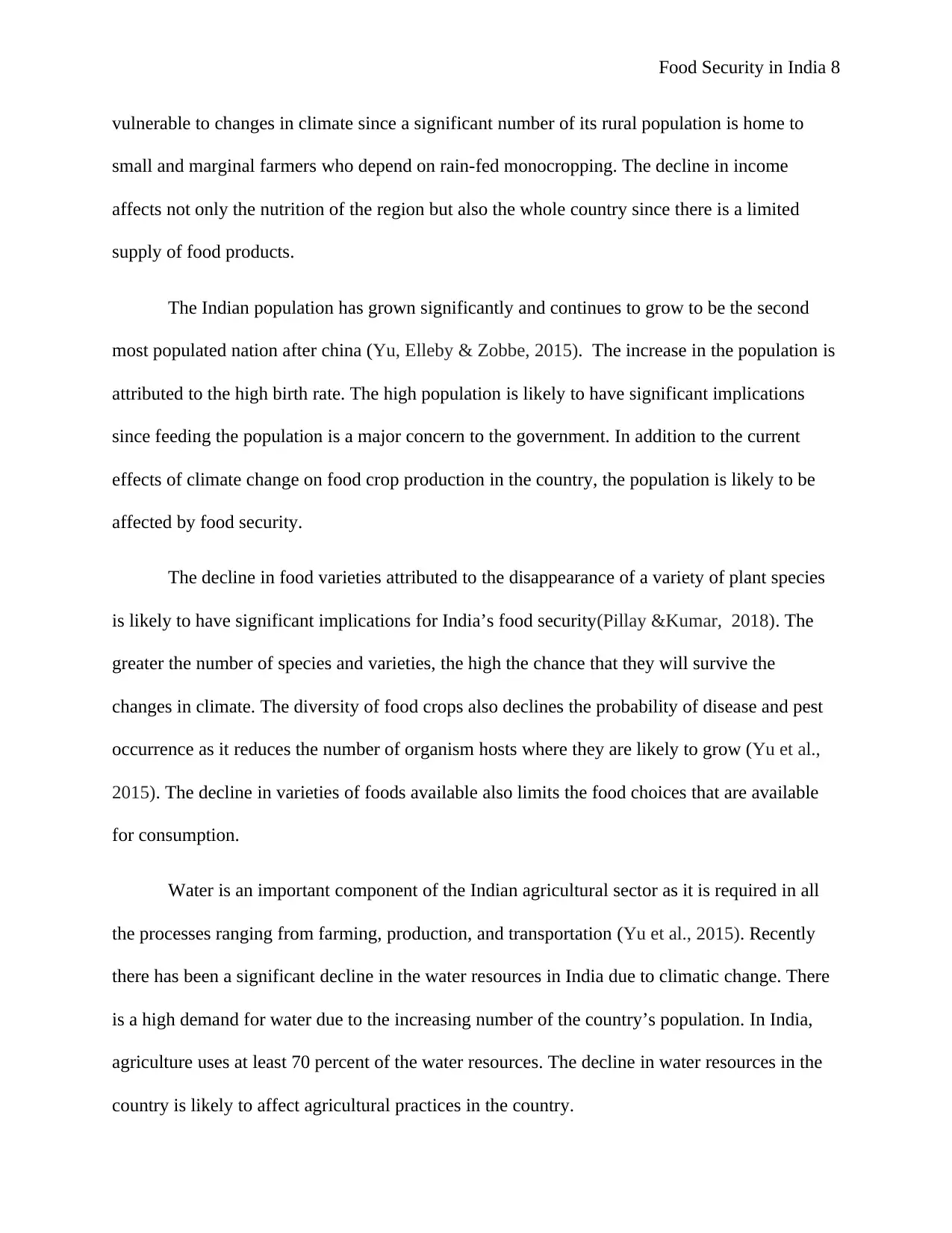
Food Security in India 8
vulnerable to changes in climate since a significant number of its rural population is home to
small and marginal farmers who depend on rain-fed monocropping. The decline in income
affects not only the nutrition of the region but also the whole country since there is a limited
supply of food products.
The Indian population has grown significantly and continues to grow to be the second
most populated nation after china (Yu, Elleby & Zobbe, 2015). The increase in the population is
attributed to the high birth rate. The high population is likely to have significant implications
since feeding the population is a major concern to the government. In addition to the current
effects of climate change on food crop production in the country, the population is likely to be
affected by food security.
The decline in food varieties attributed to the disappearance of a variety of plant species
is likely to have significant implications for India’s food security(Pillay &Kumar, 2018). The
greater the number of species and varieties, the high the chance that they will survive the
changes in climate. The diversity of food crops also declines the probability of disease and pest
occurrence as it reduces the number of organism hosts where they are likely to grow (Yu et al.,
2015). The decline in varieties of foods available also limits the food choices that are available
for consumption.
Water is an important component of the Indian agricultural sector as it is required in all
the processes ranging from farming, production, and transportation (Yu et al., 2015). Recently
there has been a significant decline in the water resources in India due to climatic change. There
is a high demand for water due to the increasing number of the country’s population. In India,
agriculture uses at least 70 percent of the water resources. The decline in water resources in the
country is likely to affect agricultural practices in the country.
vulnerable to changes in climate since a significant number of its rural population is home to
small and marginal farmers who depend on rain-fed monocropping. The decline in income
affects not only the nutrition of the region but also the whole country since there is a limited
supply of food products.
The Indian population has grown significantly and continues to grow to be the second
most populated nation after china (Yu, Elleby & Zobbe, 2015). The increase in the population is
attributed to the high birth rate. The high population is likely to have significant implications
since feeding the population is a major concern to the government. In addition to the current
effects of climate change on food crop production in the country, the population is likely to be
affected by food security.
The decline in food varieties attributed to the disappearance of a variety of plant species
is likely to have significant implications for India’s food security(Pillay &Kumar, 2018). The
greater the number of species and varieties, the high the chance that they will survive the
changes in climate. The diversity of food crops also declines the probability of disease and pest
occurrence as it reduces the number of organism hosts where they are likely to grow (Yu et al.,
2015). The decline in varieties of foods available also limits the food choices that are available
for consumption.
Water is an important component of the Indian agricultural sector as it is required in all
the processes ranging from farming, production, and transportation (Yu et al., 2015). Recently
there has been a significant decline in the water resources in India due to climatic change. There
is a high demand for water due to the increasing number of the country’s population. In India,
agriculture uses at least 70 percent of the water resources. The decline in water resources in the
country is likely to affect agricultural practices in the country.
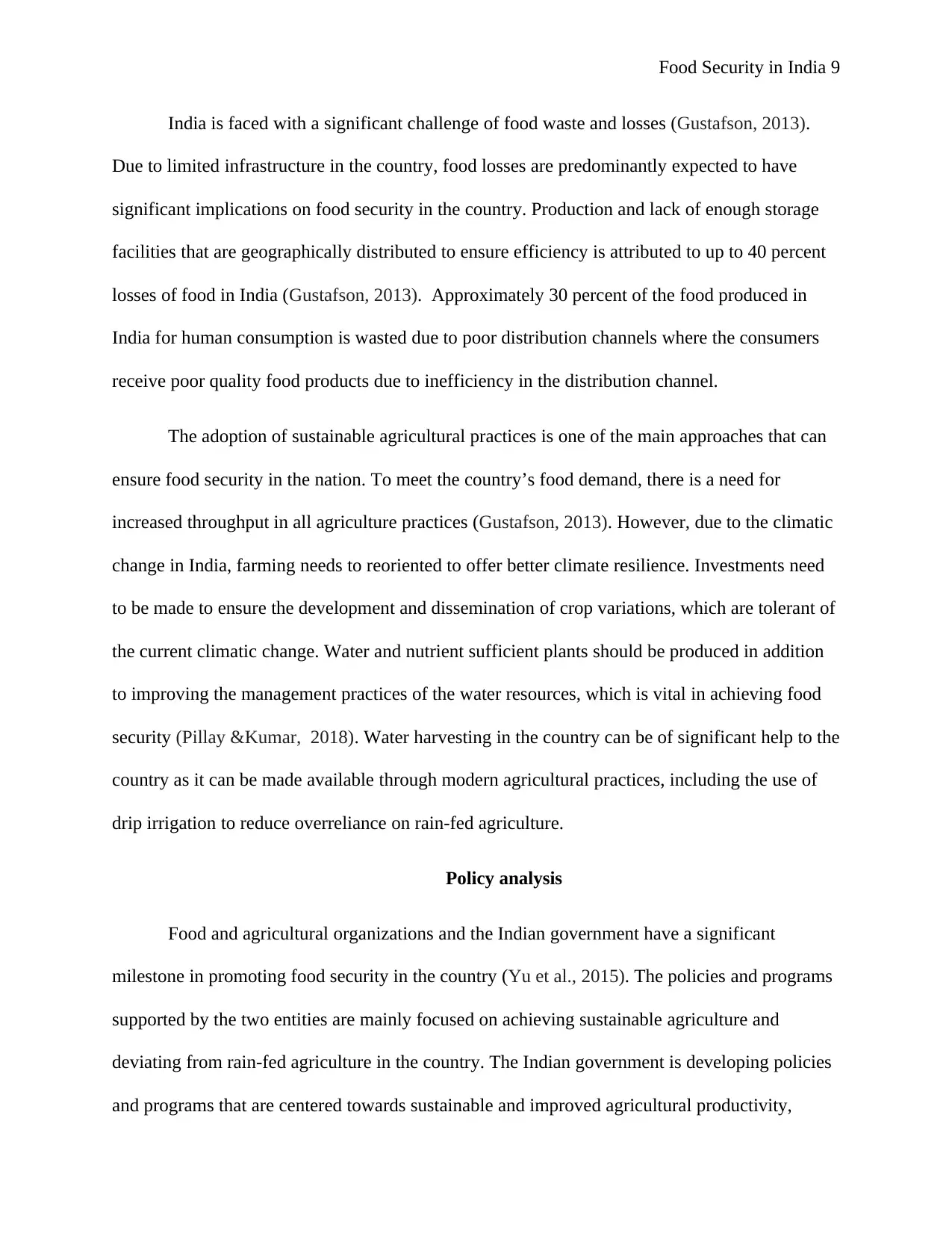
Food Security in India 9
India is faced with a significant challenge of food waste and losses (Gustafson, 2013).
Due to limited infrastructure in the country, food losses are predominantly expected to have
significant implications on food security in the country. Production and lack of enough storage
facilities that are geographically distributed to ensure efficiency is attributed to up to 40 percent
losses of food in India (Gustafson, 2013). Approximately 30 percent of the food produced in
India for human consumption is wasted due to poor distribution channels where the consumers
receive poor quality food products due to inefficiency in the distribution channel.
The adoption of sustainable agricultural practices is one of the main approaches that can
ensure food security in the nation. To meet the country’s food demand, there is a need for
increased throughput in all agriculture practices (Gustafson, 2013). However, due to the climatic
change in India, farming needs to reoriented to offer better climate resilience. Investments need
to be made to ensure the development and dissemination of crop variations, which are tolerant of
the current climatic change. Water and nutrient sufficient plants should be produced in addition
to improving the management practices of the water resources, which is vital in achieving food
security (Pillay &Kumar, 2018). Water harvesting in the country can be of significant help to the
country as it can be made available through modern agricultural practices, including the use of
drip irrigation to reduce overreliance on rain-fed agriculture.
Policy analysis
Food and agricultural organizations and the Indian government have a significant
milestone in promoting food security in the country (Yu et al., 2015). The policies and programs
supported by the two entities are mainly focused on achieving sustainable agriculture and
deviating from rain-fed agriculture in the country. The Indian government is developing policies
and programs that are centered towards sustainable and improved agricultural productivity,
India is faced with a significant challenge of food waste and losses (Gustafson, 2013).
Due to limited infrastructure in the country, food losses are predominantly expected to have
significant implications on food security in the country. Production and lack of enough storage
facilities that are geographically distributed to ensure efficiency is attributed to up to 40 percent
losses of food in India (Gustafson, 2013). Approximately 30 percent of the food produced in
India for human consumption is wasted due to poor distribution channels where the consumers
receive poor quality food products due to inefficiency in the distribution channel.
The adoption of sustainable agricultural practices is one of the main approaches that can
ensure food security in the nation. To meet the country’s food demand, there is a need for
increased throughput in all agriculture practices (Gustafson, 2013). However, due to the climatic
change in India, farming needs to reoriented to offer better climate resilience. Investments need
to be made to ensure the development and dissemination of crop variations, which are tolerant of
the current climatic change. Water and nutrient sufficient plants should be produced in addition
to improving the management practices of the water resources, which is vital in achieving food
security (Pillay &Kumar, 2018). Water harvesting in the country can be of significant help to the
country as it can be made available through modern agricultural practices, including the use of
drip irrigation to reduce overreliance on rain-fed agriculture.
Policy analysis
Food and agricultural organizations and the Indian government have a significant
milestone in promoting food security in the country (Yu et al., 2015). The policies and programs
supported by the two entities are mainly focused on achieving sustainable agriculture and
deviating from rain-fed agriculture in the country. The Indian government is developing policies
and programs that are centered towards sustainable and improved agricultural productivity,
⊘ This is a preview!⊘
Do you want full access?
Subscribe today to unlock all pages.

Trusted by 1+ million students worldwide

Food Security in India 10
which consequently increases the incomes of the farmers (Yu et al., 2015). The government aims
at improving water use efficiency in the country through the integration of modern agricultural
practices. The government is investing in research to determine crop varieties that require a
limited water supply and can thrive in high temperatures, which are consequently given to
farmers at a subsidized price (Yu et al., 2015).
FAO, On the other hand, is promoting effective natural resource management through
community development in the country (Bhan & Behera, 2014). The organization, through its
green agriculture project, offer models for successful landscape approaches to handle the
interface of biodiversity conservation in the endangered areas (Mahendra, 2014). FAO provides
technical assistance to pilot projects to the communities in support of agriculture. The
organizations promote sustained advocacy on combating anti-microbial resistance
implementation. To ensure food sufficiency, the organizations promotes better utilization of
farm-based assets and agricultural products, which is likely to reduce the cost of production of
farm products in the country (Yu et al., 2015).
Conclusion
Food security is a significant component of the Indian government due to the increase in
the country’s population. The country has the capacity to achieve food security; however, the
main challenge facing the country ss agricultural sector is low productivity attributed to the use
of unsustainable farming practices. Therefore to meet the country’s food demand, there is a need
to increase productivity and improve infrastructure to ensure limited losses and damage to the
food crops produced. Therefore offering better climate resilience farm practices in the country
will guarantee food sufficiency and even get surplus that can be exported. The country needs to
which consequently increases the incomes of the farmers (Yu et al., 2015). The government aims
at improving water use efficiency in the country through the integration of modern agricultural
practices. The government is investing in research to determine crop varieties that require a
limited water supply and can thrive in high temperatures, which are consequently given to
farmers at a subsidized price (Yu et al., 2015).
FAO, On the other hand, is promoting effective natural resource management through
community development in the country (Bhan & Behera, 2014). The organization, through its
green agriculture project, offer models for successful landscape approaches to handle the
interface of biodiversity conservation in the endangered areas (Mahendra, 2014). FAO provides
technical assistance to pilot projects to the communities in support of agriculture. The
organizations promote sustained advocacy on combating anti-microbial resistance
implementation. To ensure food sufficiency, the organizations promotes better utilization of
farm-based assets and agricultural products, which is likely to reduce the cost of production of
farm products in the country (Yu et al., 2015).
Conclusion
Food security is a significant component of the Indian government due to the increase in
the country’s population. The country has the capacity to achieve food security; however, the
main challenge facing the country ss agricultural sector is low productivity attributed to the use
of unsustainable farming practices. Therefore to meet the country’s food demand, there is a need
to increase productivity and improve infrastructure to ensure limited losses and damage to the
food crops produced. Therefore offering better climate resilience farm practices in the country
will guarantee food sufficiency and even get surplus that can be exported. The country needs to
Paraphrase This Document
Need a fresh take? Get an instant paraphrase of this document with our AI Paraphraser

Food Security in India 11
make changes and enforce agricultural policies that are aimed at improving crop productivity and
developing safety nets to deal with the risk brought about by the climatic changes.
make changes and enforce agricultural policies that are aimed at improving crop productivity and
developing safety nets to deal with the risk brought about by the climatic changes.

Food Security in India 12
References
Anderson, K., Jha, S., Nielsen, S., and Strutt, A., 2013. Re-examining policies for food security
in Asia. Food Security, 5(2), pp.195-215.
APER, T.E.O., 2013. Water and food security–Experiences in India and China.
Barik, D., and Thorat, A., 2015. Issues of unequal access to public health in India. Frontiers in
public health, 3, p.245.
Bhan, S. and Behera, UK, 2014. Conservation agriculture in India–Problems, prospects, and
policy issues. International Soil and Water Conservation Research, 2(4), pp.1-12.
Birthal, P.S., Khan, T.M., Negi, DS, and Agarwal, S., 2014. Impact of climate change on yields
of major food crops in India: Implications for food security. Agricultural Economics Research
Review, 27(347-2016-17126), pp.145-155.
Brahmanand, P.S., Kumar, A., Ghosh, S., Chowdhury, S.R., Singandhupe, R.B., Singh, R.,
Nanda, P., Chakraborthy, H., Srivastava, S.K. and Behera, MS, 2013. Challenges to food
security in India. Current Science, pp.841-846.
Bright, T., and Kuper, H., 2018. A Systematic Review of Access to General Healthcare Services
for People with Disabilities in Low and Middle-Income Countries. International journal of
environmental research and public health, 15(9), p.1879.
Chakrabarty, M., 2016. Climate Change and Food Security in India. Observer Research
Foundation (ORF): New Delhi, India.
Gitz, V., Meybeck, A., Lipper, L., Young, C.D., and Braatz, S., 2016. Climate change and food
security: risks and responses. Food and Agriculture Organization of the United Nations (FAO)
Report, 110.
Gustafson, D.J., 2013. Rising food costs & global food security: key issues & relevance for
India. The Indian journal of medical research, 138(3), p.398.
Kwasek, M., 2012. Threats to food security and standard agricultural policy. Economics of
Agriculture, 59(4), pp.701-713.
Mahendra, Dev, S., 2014. Small farmers in India: Challenges and opportunities.
References
Anderson, K., Jha, S., Nielsen, S., and Strutt, A., 2013. Re-examining policies for food security
in Asia. Food Security, 5(2), pp.195-215.
APER, T.E.O., 2013. Water and food security–Experiences in India and China.
Barik, D., and Thorat, A., 2015. Issues of unequal access to public health in India. Frontiers in
public health, 3, p.245.
Bhan, S. and Behera, UK, 2014. Conservation agriculture in India–Problems, prospects, and
policy issues. International Soil and Water Conservation Research, 2(4), pp.1-12.
Birthal, P.S., Khan, T.M., Negi, DS, and Agarwal, S., 2014. Impact of climate change on yields
of major food crops in India: Implications for food security. Agricultural Economics Research
Review, 27(347-2016-17126), pp.145-155.
Brahmanand, P.S., Kumar, A., Ghosh, S., Chowdhury, S.R., Singandhupe, R.B., Singh, R.,
Nanda, P., Chakraborthy, H., Srivastava, S.K. and Behera, MS, 2013. Challenges to food
security in India. Current Science, pp.841-846.
Bright, T., and Kuper, H., 2018. A Systematic Review of Access to General Healthcare Services
for People with Disabilities in Low and Middle-Income Countries. International journal of
environmental research and public health, 15(9), p.1879.
Chakrabarty, M., 2016. Climate Change and Food Security in India. Observer Research
Foundation (ORF): New Delhi, India.
Gitz, V., Meybeck, A., Lipper, L., Young, C.D., and Braatz, S., 2016. Climate change and food
security: risks and responses. Food and Agriculture Organization of the United Nations (FAO)
Report, 110.
Gustafson, D.J., 2013. Rising food costs & global food security: key issues & relevance for
India. The Indian journal of medical research, 138(3), p.398.
Kwasek, M., 2012. Threats to food security and standard agricultural policy. Economics of
Agriculture, 59(4), pp.701-713.
Mahendra, Dev, S., 2014. Small farmers in India: Challenges and opportunities.
⊘ This is a preview!⊘
Do you want full access?
Subscribe today to unlock all pages.

Trusted by 1+ million students worldwide
1 out of 13
Related Documents
Your All-in-One AI-Powered Toolkit for Academic Success.
+13062052269
info@desklib.com
Available 24*7 on WhatsApp / Email
![[object Object]](/_next/static/media/star-bottom.7253800d.svg)
Unlock your academic potential
Copyright © 2020–2025 A2Z Services. All Rights Reserved. Developed and managed by ZUCOL.





